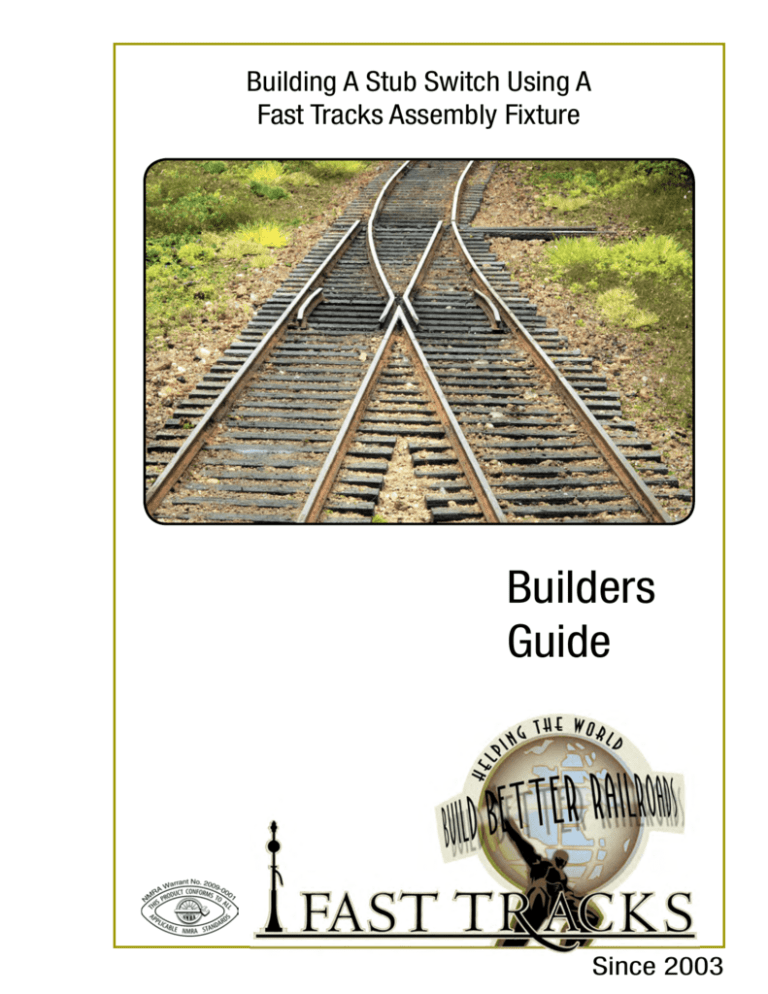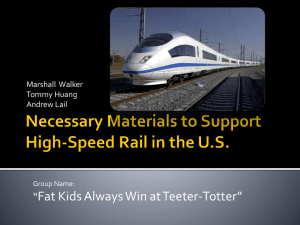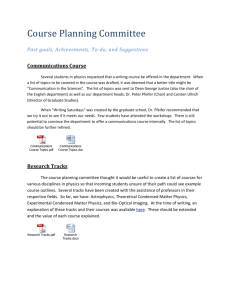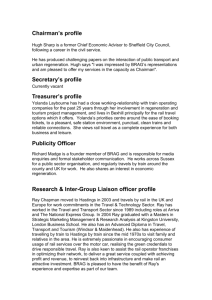
Building A Stub Switch Using A
Fast Tracks Assembly Fixture
Builders
Guide
Since 2003
Fast Tracks Builders Guide UG20
The latest version of this Builders Guide is always available for download from the Fast Tracks website at:
www.handlaidtrack.com/documents.php.
This document has been designed to be printed on both sides of the paper and bound using spiral or cerlox
binding.
This document may be freely reproduced as long as it is printed or electronically duplicated in its entirety
without modification and is not made part of another document.
Written & Published by
Fast Tracks
312-B St. Patrick St.
Port Dover, Ontario
N0A 1N0 CANADA
Email: service@fast-tracks.net
Phone: 1-888-252-3895
Web: www.fast-tracks.net or www.handlaidtrack.com
This document was last updated on October 9, 2015
All content & images are copyright © 2015 Fast Tracks, All rights reserved.
DISCLAIMER: While we have made every effort to ensure that this users’ guide is accurate, we cannot guarantee it to be
100% free from errors or inaccuracies. FAST TRACKS HOBBYWORKS INC., NOR ANY OF THEIR EMPLOYEES SHALL NOT
BE LIABLE FOR ANY DAMAGES INCLUDING, BUT NOT LIMITED TO, DIRECT, INDIRECT, SPECIAL, INCIDENTAL OR CONSEQUENTIAL DAMAGES OR OTHER LOSSES ARISING OUT OF THE USE OF OR INABILITY TO USE ANY FAST TRACKS PRODUCT.
Thank You For Buying Fast Tracks Products!
Fast Tracks was born out of my frustration with building accurate and reliable
turnouts by hand. I just felt that there had to be a better way. So after a lot of
experimenting and trial and error I came up with a solution that worked so well,
that I decided to offer track assembly fixtures for sale to other model railroaders.
I have spent a lot of time ‘sweating the details’ and have worked hard to produce the highest quality product possible. If you are not 100% satisfied with your
Fast Tracks product, or are not getting the results that you expected, then please
contact me directly at service@fast-tracks.net and I will try and help you out, or
arrange to refund your money.
If you are happy with your Fast Tracks product, then please tell your friends! Despite our hyper-linked and over-connected society, I still rely mostly on satisfied
customers and word of mouth to promote my products.
You will always find the latest version of these instructions on the Fast Tracks
website at www.handlaidtrack.com/documents.php. I would suggest that you
bookmark this address in your browser so that if you ever misplace or wear out
these instructions you will be able to download another copy from our website.
We also maintain an online discussion forum about Fast Tracks products on our
website at www.handlaidtrack.com/forums. There you will find a host of information & advice from myself and other customers. Why not drop by and tell us
how you are making out with your hand laid track project?
I also publish a personal blog on the Internet at www.bronx-terminal.com. I regularly post images, videos and comments about the progress I am making with
my personal projects, so stop buy and have a look!
Also, Fast Tracks is on Facebook! If you are a Facebook user, join our Fast
Tracks page as I frequently update it with what is going on here during the day.
Again, thank you for your purchase. And please do not hesitate to contact me if
you have any questions or problems with your product. I will do my best to reply
within one business day.
Tim Warris & the staff of Fast Tracks
service@fast-tracks.net
www.fast-track.net
Copyright © 2015 Fast Tracks
Page 1
Building A Stub Turnout
Stub turnouts, or the more generic term, “Stub Switch”, are the precursor to today’s
modern turnouts. Stub turnouts are different from modern turnouts in that there were
no moving switchpoints. Instead the routes were changed by actually moving the rails
leading up to the turnout. Using a manually operated switch stand, and some real
muscle, brakemen would physically warp the rail leading into the turnout. These were
much easier for the railroads of the day to build, but had a number of major drawbacks.
They were very rough to travel over. The hard banging of wheels onto the ends of the
rails caused damage and the rail had to be frequently repaired. And trains could only
operate at low speed through the turnout as it was a bone jarring bump from one route
to another.
Around the turn of the century most of these were replaced with their modern counterpart that used moveable switchpoints that eliminated all of the problems associated
with a stub turnout. However backwoods logging and coal operations continued to use
stub turnouts long after other types of operations dropped them, some are even still in
use today.
Building a model of a stub switch is done in two parts. Part one is to build or prepare
the upper portion of the turnout. The methods used to build the upper part of the switch
are the same as building a standard turnout, so refer to our Turnout Builders Guide for
detailed instructions for this part.
Original patent drawing of a stub turnout commonly used in
the 19th and early 20th centuries
Copyright © 2015 Fast Tracks
Page 2
The second part of the process is to build a movable bridle - the part of the turnout that
actually moved back and forth to select the route.
What makes stub turnouts a bit more difficult to construct is the need for a mechanical
stop. Unlike a turnout with switchpoints, a stub switch has to have something to physically stop the movement of the bridle when it is in position. The prototype uses a cast
part to hold the closure rails in place, and cast into this part are stops. Unfortunately
nothing like this exists for our models, so this Builders Guide will describe a simple but
effective method for building stops.
Prototype stub switches also have a series of bars fastened to the rails to hold them in
place to allow them to be switched as a single unit. For our model we will be using a
single PC board tie with rail joiners soldered to it to allow the rails to properly slide back
and forth. This is a compromise that has to be made as there is no material that I am
aware of that could be used to model the bars accurately and still have the necessary
strength to keep the rails aligned. This tie will be extended out the side of the turnout to
allow it to be reliably connected to either a switch machine or a ground throw.
A prototype stub turnout typically has only a single head tie (the long ties where the
switch stand is held) so our model will also use a single head tie.
You can build a stub switch using any standard Fast Tracks assembly fixture with PC
Board ties, and the matching QuickSticks laser cut ties.
Craftsman Series Build
We recommend that you gain some experience
in building standard turnouts before you attempt
to build a Stub Turnout. This document assumes
that you are familiar with the methods for building a standard turnout in a Fast Tracks assembly
fixture, and that you have mastered basic turnout construction techniques and soldering skills.
Copyright © 2015 Fast Tracks
Page 3
Curved Stub Turnouts
To build a curved stub turnout,
simply follow the instructions in
this document. The only difference is that you need to curve
the rail to match the curved rail
slots before you insert the rail
into the assembly fixture.
Our Rail Roller rail bending tool makes
this very easy and is highly recommended. You can learn more about the Fast
Tracks Rail Roller on our website at:
www.handlaidtrack.com/tl-0004.php.
Copyright © 2015 Fast Tracks
Page 4
Related Documents
The following documents are referred to in this document and will be needed during
construction. You may want to print copies of them now.
These documents will be included on the documentation DVD that you received with
your fixture, or you can download the latest version from our website at:
www.handlaidtrack.com/documents.php.
• Building Turnouts Using Fast Tracks Assembly Fixtures - UG01
• Using The Fast Tracks PointForm Tool - UG10
• Using Fast Tracks PC Board Ties - UG09
• Using The Fast Tracks Rail Roller (Curved turnouts only) - UG12
• Developing Good Soldering Techniques - AN01
NMRA Compliancy & MMR Certification
Turnouts built with Fast Tracks tools and following the
instructions provided in this document and in our Using
Fast Tracks Assembly Fixtures video will be NMRA compliant.
Fast Tracks tools may be used to construct trackwork for
your Civil Engineering certificate, however you should always confirm NMRA compliancy by checking the turnout using your NMRA track gauge.
Copyright © 2015 Fast Tracks
Page 5
Supplies You Will Need
1. Rail
2. Turnout PC Board Ties
3. Rail Joiners
4. Rail Spikes
5. Flat Washers (The thickness of the washer should be slightly less than a PC
Board tie.)
6. Wood screws that fit the flat washers
7. Wood Ties
8. TwistTies (optional - you can use standard wood ties if you prefer.)
Copyright © 2015 Fast Tracks
Page 6
Part 1 - Building The Upper Turnout
Start by building a turnout that includes everything down to the tie above the throwbar.
Image 1 shows all of the necessary ties placed into the fixture.
Just build the turnout as you normally would with the stock rails cut
just below the third tie. (Image 2)
Image 1
Click The Images For
A Larger View!
If you are viewing this
document on your computer,
and you have access to the
internet, click on any image
for a larger, high resolution
version.
Image 2
The turnout is built a bit longer than
necessary and will be trimmed to
length. Image 3 shows the finished
trackwork set onto the QuickSticks
ties. This will help you determine
where you need to position the head
tie.
Image 3
Copyright © 2015 Fast Tracks
Page 7
Image 4
The moveable bridle rails will meet
the turnout at a location where the
stock and closure rails are spaced
approximately the same distance
apart as the flangeways are in the
frog area. To determine this location
use the “NO-GO” tab on an NMRA
track gauge to locate where the
rails are far enough apart. (Image 4)
You want this position to be at the
same location as a wood tie.
Mark this location onto the rail head
with a marker. (Image 5) We will be
soldering an additional PC Board tie
at this location to act as the head
tie.
Image 5
Now remove the assembly from
the fixture and carefully solder a PC
Board tie at the location you marked
on the rail. (Image 6) Be sure to
position the long side of the tie on
the side where the switch machine/
ground throw will be used.
Confirm that the tie is sitting parallel to the other PC Board ties before
soldering it into place. It may help
to tape the turnout and the tie onto
a flat surface to keep everything
stable while soldering.
Image 6
Copyright © 2015 Fast Tracks
Page 8
Image 7
After soldering the head tie into
place, the rails are cut off just past
the end of the head tie. Don’t try to
cut the stock and closure rails at
the same time, or cut too close to
the head tie as you will damage the
rail. Instead cut the stock rails off
first. (Image 7)
Then cut the stock and closure rails
off close to the edge of the tie, but
not right next to it. You will file the
rails flush to the tie in the next step.
(Image 8)
Image 9 shows the rails cut close
to the tie. You want to cut the rails
carefully to avoid crushing or deforming them.
Image 8
Image 9
Copyright © 2015 Fast Tracks
Page 9
Image 10
Using a large file, file the rail flush
to the edge of the PC board tie. (Image 10)
With the rail filed flush, the upper
half of the stub turnout can be set
aside as we prepare the moveable
bridle. (Image 11)
To allow the rails to properly move
in the bridle we will use two rail
joiners soldered to a PC Board tie.
These joiners will act as guides that
will allow the rail to slide up and
down in the joiners when the rails
are moved back and forth. (Image
12)
Image 11
Image 12
Copyright © 2015 Fast Tracks
Page 10
Image 13
Rail joiners are a bit too long and
will need to be cut the same width
as a PC Board tie. The PointForm
tool will work well as a clamp to
hold a piece of rail in place while we
cut two rail joiners to length.
Slide a rail joiner onto a length of
rail held in the PointForm tool. Position the rail joiner so that it extends
by the width of a PC Board tie beyond the end of the rail. (Image 13)
Using a jewelers saw and a fine
tooth blade cut the rail joiner off
flush to the end of the rail. A cut-off
disk in a rotary tool also works well
for this. (Image 14)
Image 14
There is a small tab on the end of
the rail joiner. Nip this off with a pair
of rail cutters. (Image 15)
Image 15
Copyright © 2015 Fast Tracks
Page 11
Slide the rail joiner section onto a
length of rail to hold it steady and
carefully file off any burrs. (Image
16)
Image 16
Next we need to solder the rail joiners onto the PC Board ties. To make
sure that the joiners and ties are
properly spaced and held square,
it is easiest to use the Assembly
Fixture to hold everything in place
while you are soldering.
The PC Board throwbar tie at the
end of the bridle needs to be extra long as the switch machine or
ground throw needs to be offset to
one side of the bridle.
Image 17
Here I am using the end tie pocket,
and two additional pockets about 3”
back. (Image 17) This is the section
that will flex.
Cut two lengths of rail about the
length of the fixture for the bridle
and slide the rail joiner sections
onto each of rail. (Image 18)
Image 18
Copyright © 2015 Fast Tracks
Page 12
Insert the rails into the fixture and
align the rail joiner sections onto the
long tie at the end of the bridle. The
ends of the rails should protrude at
least a couple tie lengths past the
end of the PC board tie. (Image 19)
We will trim these off later on.
Image 19
Flux and solder the rail joiners onto
the PC Board tie. DO NOT solder the
rail to the rail joiner, the rail must be
able to slide within the rail joiners.
(Image 20)
Solder the rail to the other PC Board
ties in the fixture. (Image 21)
Image 20
Image 21
Copyright © 2015 Fast Tracks
Page 13
This section can now be removed
from the fixture. The rail should
easily flex from side to side from
the long tie at the end of the bridle.
(Image 22)
Image 22
Set the turnout on top of the QuickSticks and mark the end of the last
wood tie and cut the QuickSticks
at this location. (Image 23) Discard
the bottom section with the head
ties and glue the trackwork onto the
QuickSticks using Pliobond adhesive.
The turnout can now be glued into
place on the roadbed along with
the wood crossties under the bridle.
(Image 24)
Image 23
You need to use standard wood ties
under the section of the bridle that
will flex back and forth as shown in
Image 24.
You can use either standard wood
ties or Fast Tracks TwistTies for the
rest of the switch. Here we are using TwistTies.
Gaps have been left to accommodate
the PC Board ties on the bridle.
Before setting the bridle on top of
the ties, lightly sand the wood ties
that are under the flexible section
of the bridle to ensure that the rail
heads will sit flush. Failure to do so
will result in a bumpy turnout.
Image 24
Finally, note that a hole has been
drilled for the wire of an undermount switch machine. Due to
tight clearances at the center of the
turnout, the machine needs to be
mounted offset to the tie.
Position the bridle onto the wood
ties, ensuring that the PC Board ties
Copyright © 2015 Fast Tracks
Page 14
Image 25
are properly centered between the
wood ties. Then using a scribe or
sharp knife, mark the location of the
end of the upper section of the turnout onto the bridle rails. (Image 25)
Carefully trim and file the rail to
length. Take care to ensure a good
fit with the smallest amount of
clearance possible. (Image 26)
To keep the throwbar tie in its proper location we will fashion small
keepers from spikes.
Using a scribe or other sharp object,
carefully mark the location where
these spikes will be inserted into
the roadbed. Be certain that the
spikes are offset far enough from
the rail to allow the rail to flex into
position.
Image 26
Notice that the copper has been
filed off the top of the PC board
throwbar tie. This is to keep the
shiny surface from showing after it
has been used for a while. (Image
27)
Image 27
Copyright © 2015 Fast Tracks
Page 15
Carefully insert the spikes into
place, capturing the PC Board tie
but still allowing it to slide freely.
(Image 28) (Image 29)
Image 28
To build a reliable, adjustable stop
for the bridle we need to make a
couple of eccentrics from two small
washers. These washers need to
be thick enough that when they are
mounted onto the roadbed the end
of the bridle tie will sit against them
so they act as a positive stop.
Clamp the washers into a vise and
file one side into a slight arc. Using
a bench top belt sander will speed
this process up considerably. (Image 30)
Image 29
Image 30
Copyright © 2015 Fast Tracks
Page 16
Image 31
With the bridle in position for the
straight route, screw the washer
into the roadbed. Leave a small
amount of clearance between the
end of the bridle tie and the washer.
(Image 31)
Now carefully rotate the washer until the tie sits tight against it and the
rails line up precisely. (Image 32)
Repeat this process for the other
end of the bridle tie and adjust into
position for the diverging route. (Image 33)
Image 32
Image 33
Copyright © 2015 Fast Tracks
Page 17
Double check the alignment of the
bridle relative to the turnout, making
adjustments as necessary. (Image
34)
Image 34
Secure the washer to the roadbed
with a thin CA adhesive. Don’t glue
the bridle to the roadbed! (Image
35)
Once the glue has thoroughly cured,
remove the screws. The washers
will be buried under scenic materials when the turnout is ballasted in
place.
That’s it! The turnout is complete.
Attach your favorite switch machine
or ground throw, wire it up, and it
is ready to deliver years of reliable
service.
Image 35
Copyright © 2015 Fast Tracks
Page 18
Copyright © 2015 Fast Tracks
Page 19
Copyright © 2015 Fast Tracks
Page 20
Copyright © 2015 Fast Tracks
Page 21









